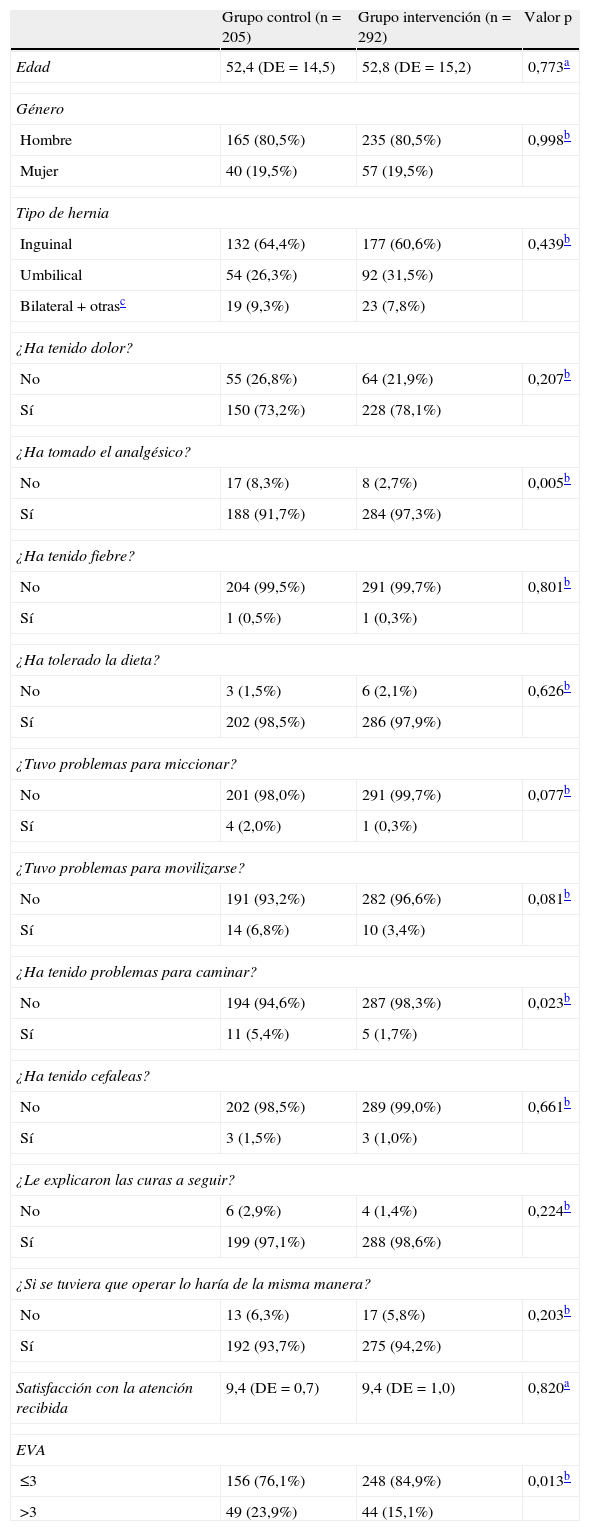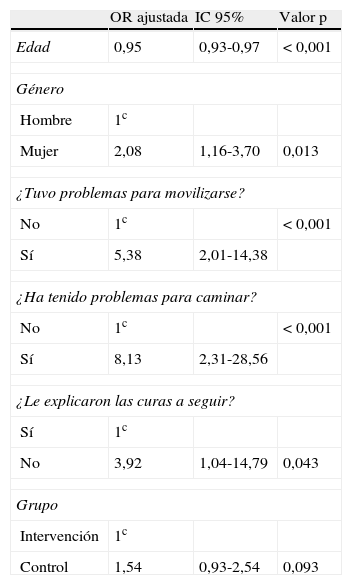Evaluar la eficacia de una intervención educativa de enfermería preoperatoria mediante entrega de material gráfico para la gestión del dolor agudo post-operatorio en los pacientes intervenidos de hernias en una unidad de cirugía mayor ambulatoria (UCMA).
MétodoEstudio cuasi experimental (no aleatorizado). Grupo control, pacientes intervenidos de hernia entre julio de 2006 y junio de 2007 y grupo intervención, pacientes intervenidos entre julio de 2007 y junio de 2008. Ambos grupos recibieron la misma acción formativa para la preparación quirúrgica y recomendaciones para el post-operatorio en la consulta de enfermería. Al grupo intervención se reforzó la información con la entrega de material gráfico. La recogida de datos se realizó mediante cuestionario al ingreso y llamada telefónica a las 24h post-operatorias. La medición del dolor se realizó con la escala visual analógica/escala verbal numérica (EVA/EVN).
ResultadosSe incluyeron 205 pacientes en el grupo control y 292 en el grupo intervención. En el análisis bivariado el porcentaje de pacientes con EVA > 3 fue del 23,9% para el grupo control y del 15,1% para el grupo intervención. En el análisis multivariante las variables asociadas al dolor post-operatorio fueron la edad joven, género femenino, problemas para movilizarse y caminar, y falta de conocimiento de los cuidados a seguir en casa.
ConclusionesUna intervención educativa de enfermería con la entrega de material gráfico sugiere que puede reducir la percepción individual del dolor agudo post-operatorio así como disminuir el porcentaje de pacientes con problemas para caminar, movilizarse y mejorar el cumplimiento y adhesión al tratamiento.
Evaluate the effectiveness of educational intervention of perioperative nursing by providing graphic material for the management of postoperative pain in patients operated on for hernia in an Ambulatory Surgery Unit (ASU).
MethodA quasi-experimental (non-randomised) study, with a control group with patients undergoing hernia between July 2006 and June 2007 and an intervention group with patients treated between July 2007 and June 2008. Both groups were given the same training on the surgical and postoperative recommendations for perioperative nursing clinics. The intervention group was reinforced with the provision of information in graphic form. The data was collected using a questionnaire at admission and phone call within 24hours postoperative. Pain measurement was made with the visual analogue scale / verbal numerical rating scale (VAS/VNRS).
ResultsA total 205 patients were included in the control group and 292 in the intervention group. In the bivariate analysis, the percentage of patients with VAS >3 was 23.9% for the control group and 15.1% for the intervention group. In the multivariate analysis, the variables associated with postoperative pain were: low age, female sex, mobility and walking problems, and lack of knowledge about post-discharge home-care guidelines.
ConclusionsNursing educational intervention with the provision of graphic material, suggests that it may reduce the individual's perception of postoperative pain, decrease the percentage of patients with mobility and walking problems, and improve compliance and adherence to treatment.
Artículo
Comprando el artículo el PDF del mismo podrá ser descargado
Precio 19,34 €
Comprar ahora









